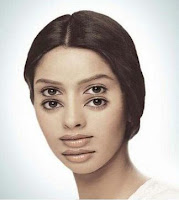 |
| Early Palm Treat design for a 4 inch vinyl sticker. |
The Origins of Palm Treat
"Frankly, I am not sure where my ideas come from. I have been inspired by everything from passing images in my mind to brief glimpses of reflections in shop windows… anything that generates that initial flash of excitement. When I was developing the early ideas that Palm Treat's art is based on (distorted features, multiple sets of eyes, appropriated cartoon imagery) I was inspired by Facebook's early advertising failures. I read a study about how ineffective their early ad attempts were, in short no one was intentionally clicking on them. In the study I read they paid for something like 30,000 targeted views for a survey or some such thing and received something like 2 or 3 clicks that immediately bounced. I've worked as a web designer and this is an unimaginably terrible respsonse to online advertising. |
| The image that inspired Palm Treat. |
This made a great impact on me, I spent days thinking about the ad and marveling at how such a simple and stupid idea was so incredibly effective when so many other advertisements had failed. I knew that our brains are configured to recognize facial patterns above all else, and that faces are very good at getting our attention, but I was endlessly facinated with how such a simple variation to the human face seemed to short circuit the brain's attention. Or maybe not short circuit our facial recognition, but more hyper activate it. Somehow a face with multiple sets of eyes triggered an incredibly strong response and a great amount of interest. It was as though our human eyes were magnetized.
As a designer I let this idea sit in my mind for the better part of a year. I knew that there was something significant or at least profitable to be done with this idea. The difficulty was figuring out how to implement it into an interesting type of art without just painting a bunch of portraits with too many eyes. Which I wasn't exactly opposed to, but it just seemed as though there must be a more effective or clever use of it.
I have always had a great interest in pop artists like Andy Warhol, Roy Lichtenstein, and Jasper Johns. I grew up on cartoons and loved how they straight up stole the cartoon imagery of their childhoods and turned it into large scale art, many times without altering it outside of the dimensions and medium. I was particularly inspired by Roy Lichtenstein's gigantic comic book panels after seeing some in person as a young child, they seemed so environmental and epic in their large scale, they were exciting. I feel that excitement is the most important factor in any type of art, arousing enthusiasm for a particular feeling or way of being.
So I ultimately landed on combining my favorite childhood cartoon, the Simpsons, with my new idea about facial distortions and repetitive patterns. I also felt that the Simpsons was a strong source to work from as they are the most popular and widely recognized cartoon characters ever conceived, I liked the idea of playing to the largest common demoninator. So, I printed out a few pictures of Bart Simpson on some shipping labels at my job and within a few minutes saw endless possiblities in exploiting the economy of form used in cartoons. Not just the Simpsons, but all cartoons… everything for that matter. It felt like sampling an image into a techno beat, it was enlightening.
From that initial discovery, I set out Photoshopping, tracing, re-drawing, hacking and cutting up everything I could find. At this point I have created years worth of source material. I have a lifetime of trippy pop art pasted together in Photoshop documents. At this point, its just about putting our stuff out there for as many people as we can find to put it in front of
No comments:
Post a Comment